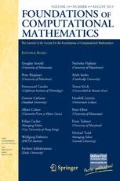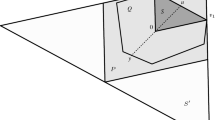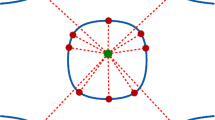Abstract
The mixed volume counts the roots of generic sparse polynomial systems. Mixed cells are used to provide starting systems for homotopy algorithms that can find all those roots and track no unnecessary path. Up to now, algorithms for that task were of enumerative type, with no general non-exponential complexity bound. A geometric algorithm is introduced in this paper. Its complexity is bounded in the average and probability-one settings in terms of some geometric invariants: quermassintegrals associated with the tuple of convex hulls of the support of each polynomial. Besides the complexity bounds, numerical results are reported. Those are consistent with an output-sensitive running time for each benchmark family where data are available. For some of those families, an asymptotic running time gain over the best code available at this time was noticed.







Similar content being viewed by others
Abbreviations
- \(V(\mathcal A_1, \dots , \mathcal A_n)\) :
-
Mixed volume of \(\mathcal A_1, \dots , \mathcal A_n\).
- \(A_i\) :
-
Finite subset of \(\mathbb Z^n\).
- V :
-
Scaled mixed volume \(n!V( \mathrm {Conv}(A_1), \ldots , \mathrm {Conv}(A_n))\).
- \(V_i\) :
-
Generic root bound of an unmixed system of support \(A_i\).
- \(T, T'\) :
-
Time bounds for the algorithm
- s :
-
Number of different supports \(A_i\).
- \(m_i\) :
-
Multiplicity of each support \(A_i\).
- \(b_i = b_i(\mathbf a) = b(i, \mathbf a)\) :
-
Lifting value for \(\mathbf a \in A_i\).
- \(\lambda _i = \lambda _i(\mathbf \xi )\) :
-
Legendre dual for the lifting \(b_i\).
- \(m_i(\varvec{\xi })\) :
-
Number of times \(\lambda _i(\mathbf \xi )\) attained, minus one.
- \(L_{i,\varvec{\xi }}\) :
-
Facet of \(\mathrm {Graph}(\hat{b}_i)\).
- \(L_{\varvec{\xi }}\) :
-
Facet of \(\mathrm {Graph}(\sum t_i \hat{b}_i), t_i\) indeterminates.
- \(\Xi (L)\) :
-
Possibly unbounded polyhedron dual to face L.
- \(F_0 \subset \cdots \subset F_n\) :
-
Generic affine flag in \(\mathbb R^n\).
- \({m_{i}^{(d)}}\) :
-
Certain non-decreasing sequence.
- \(X_d\) :
-
Certain zero-dimensional tropical variety.
- \({G}_d\) :
-
Certain one-dimensional tropical variety.
- \(\mathbf C, \mathbf b\) :
-
Cayley matrix and lifting vector.
- q :
-
Last polytope so that \({m_{q}^{(d)}}\) increased at time d.
- \(\Delta _j\) :
-
Pivoting direction, in \(\xi \)-space.
- \(I_j\) :
-
Pivoting distance.
- \(\Delta _j \varvec{\xi }, \Delta _j \varvec{\lambda }\) :
-
Pivoting vectors while dropping constraint j.
- \(\mathbf {C}_{\mathrm {act}}, \mathbf b_{\mathrm {act}}\) :
-
Matrix and vector of active constraints.
- \(\mathbf {C}_{\mathrm {inact}}, \mathbf b_{\mathrm {inact}}\) :
-
Matrix and vector of inactive constraints.
- \(t(i,\mathbf a)\) :
-
score of inactive constraint \([i, \mathbf a]\)
- \(Q_i\) :
-
Unit vector orthogonal to \(F_{i-1}\) in \(F_i\).
- R :
-
nonstandard number, \(R>k\) for all \(k \in \mathbb R\).
- B :
-
Inverse to the matrix \(\mathbf {C}_{\mathrm {act}}\) of active constraints.
- \(t_{i,a}(R)\) :
-
Scores for inactive constraints.
- \(\Gamma = (\mathcal V, \mathcal E)\) :
-
Graph to be explored. Union of tropical curves.
- \(v_d\) :
-
number of vertices of \({G}_d\).
- \(E_i\) :
-
Degree of 1-skeleton of lifting of \(A_i\)
References
Barvinok, A. 1997. Computing mixed discriminants, mixed volumes, and permanents, Discrete Comput. Geom. 18, no. 2, 205-237, doi:10.1007/PL00009316.
Bernstein, D. N. 1975. The number of roots of a system of equations, Funkcional. Anal. i Priložen. 9, no. 3, 1-4 (Russian).
Bernstein, D. N., A. G. Kušnirenko, and A. G. Hovanskĭ. 1976. Newton polyhedra, Uspehi Mat. Nauk 31, no. 3(189), 201-202 (Russian).
Chen, Tianran, Tsung-Lin Lee, and Tien-Yien Li. 2014. Mixed volume computation in parallel, Taiwanese J. Math. 18, no. 1, 93-114, doi:10.11650/tjm.18.2014.3276.
Cartwright, Dustin and Sam Payne. 2012. Connectivity of tropicalizations, Math. Res. Lett. 19, no. 5, 1089-1095, doi:10.4310/MRL.2012.v19.n5.a10.
Demmel, James W. 1997. Applied numerical linear algebra, Society for Industrial and Applied Mathematics (SIAM), Philadelphia, PA.
Dyer, Martin, Peter Gritzmann, and Alexander Hufnagel. 1998. On the complexity of computing mixed volumes, SIAM J. Comput. 27, no. 2, 356-400, doi:10.1137/S0097539794278384.
Emiris, Ioannis Z. 1996. On the complexity of sparse elimination, J. Complexity 12, no. 2, 134- 166, doi:10.1006/jcom.1996.0010.
Emiris, Ioannis Z. and John F. Canny. 1995. Efficient incremental algorithms for the sparse resul- tant and the mixed volume, J. Symbolic Comput. 20, no. 2, 117-149, doi:10.1006/jsco.1995.1041.
Emiris, Ioannis Z. and Vissarion Fisikopoulos. 2014. Efficient Random-Walk Methods for Ap- proximating Polytope Volume, 30th Annual Symposium on Computational Geometry, SOCG’14, Kyoto, Japan, June 08 - 11, 2014, pp. 318.
Emiris, Ioannis Z. and Raimundas Vidunas. 2014. Root counts of semi-mixed systems, and an application to counting Nash equilibria, ISSAC’14, pp. 154-161.
Gao, Tangan and T. Y. Li. 2000. Mixed volume computation via linear programming, Taiwanese J. Math. 4, no. 4, 599-619.
Gao, Tangan, T. Y. Li, and Mengnien Wu. 2005. Algorithm 846: MixedVol: a software pack- age for mixed-volume computation, ACM Trans. Math. Software 31, no. 4, 555-560, doi:10.1145/1114268.1114274.
Gurvits, Leonid. 2009. A polynomial-time algorithm to approximate the mixed volume within a simply exponential factor, Discrete Comput. Geom. 41, no. 4, 533-555, doi:10.1007/s00454-009-9147-5.
Huber, Birkett and Bernd Sturmfels. 1995. A polyhedral method for solving sparse polynomial systems, Math. Comp. 64, no. 212, 1541-1555, doi:10.2307/2153370.
Jensen, Anders. 2016. Tropical Homotopy Continuation, available at http://arxiv.org/abs/1601.02818.
Khachiyan, L. G. 1989. The problem of calculating the volume of a polyhedron is enumeratively hard, Uspekhi Mat. Nauk 44, no. 3(267), 179-180, doi:10.1070/RM1989v044n03ABEH002136 (Russian); English transl.,. 1989, Russian Math. Surveys 44, no. 3, 199-200.
Knuth, Donald E. 1998. The art of computer programming. Vol. 3, Addison-Wesley, Reading, MA.
Le Gall, François. 2014. Powers of Tensors and Fast Matrix Multiplication, Proceedings of the 39th International Symposium on Symbolic and Algebraic Computation (ISSAC 2014), pp. 296- 303.
Lee, Tsung-Lin and Tien-Yien Li. 2011. Mixed volume computation in solving polynomial system- s, Randomization, relaxation, and complexity in polynomial equation solving, Contemp. Math., vol. 556, Amer. Math. Soc., Providence, RI, pp. 97-112, doi:10.1090/conm/556/11009, (to appear in print).
Li, T. Y. and Xing Li. 2001. Finding mixed cells in the mixed volume computation, Found. Comput. Math. 1, no. 2, 161-181, doi:10.1007/s102080010005.
Maclagan, Diane and Bernd Sturmfels. 2015. Introduction to Tropical Geometry, American Mathematical Society, Providence, RI.
Malajovich, Gregorio. 2013. On the Expected Number of Zeros of Nonlinear Equations, Found. Comput. Math. 13, no. 6, 867-884, doi:10.1007/s10208-013-9171-y.
Malajovich, Gregorio and J. Maurice Rojas. 2004. High probability analysis of the condition number of sparse polynomial systems, Theoret. Comput. Sci. 315, no. 2-3, 524-555, doi:10.1016/j.tcs.2004.01.006.
Minkowski, Hermann. 1901. Sur les surfaces convexes fermées, C.R. Acad.Sci., Paris 132, 21-24.
Mizutani, Tomohiko and Akiko Takeda. 2008. DEMiCs: a software package for computing the mixed volume via dynamic enumeration of all mixed cells, Software for algebraic geometry, IMA Vol. Math. Appl., vol. 148, Springer, New York, pp. 59-79, doi:10.1007/978-0-387-78133-4, (to appear in print).
Mizutani, Tomohiko, Akiko Takeda, and Masakazu Kojima. 2007. Dynamic enumeration of all mixed cells, Discrete Comput. Geom. 37, no. 3, 351-367, doi:10.1007/s00454-006-1300-9.
Morgan, Alexander. 1987. Solving polynomial systems using continuation for engineering and scientific problems, Prentice Hall, Inc., Englewood Cliffs, NJ.
Preparata, Franco P. and Michael Ian Shamos. 1985. Computational geometry, Texts and Monographs in Computer Science, Springer-Verlag, New York. An introduction.
Uhler, Caroline. 2012. Geometry of maximum likelihood estimation in Gaussian graphical models, Ann. Statist. 40, no. 1, 238-261, doi:10.1214/11-AOS957.
Vassilevska Williams, Virginia. 2012. Multiplying matrices faster than Coppersmith-Winograd, Proceedings of the forty-fourth annual ACM symposium on Theory of computing, pp. 887-898.
Verschelde, Jan. 1999. Algorithm 795: PHCPack: A general-purpose solver for polynomial sys- tems by homotopy continuation, ACM Transactions on Mathematical Software 25, no. 2, 251-276.
Verschelde, J., K. Gatermann, and R. Cools. 1996. Mixed-volume computation by dynamic lift- ing applied to polynomial system solving, Discrete Comput. Geom. 16, no. 1, 69-112, doi:10.1007/BF02711134.
Yu, Josephine. 2015. Do most polynomials generate a prime ideal?, available at http://arxiv.org/abs/1509.02050.
Author information
Authors and Affiliations
Corresponding author
Additional information
Communicated by Bernd Sturmfels.
A substantial part of this paper was written while visiting the Simons Institute for the Theory of Computing in the University of California at Berkeley. This visit was funded by CAPES (Coordenação de Aperfeiçoamento de Pessoal de Nível Superior, Brazil. Proc. BEX 2388/14-6). This research is also funded by CNPq, Grants 441678/2014-9 and 306673/2013-4. Numerical experiments were performed at NACAD (Núcleo Avançado de Computação de Alto Desempenho) at UFRJ.
Rights and permissions
About this article
Cite this article
Malajovich, G. Computing Mixed Volume and All Mixed Cells in Quermassintegral Time. Found Comput Math 17, 1293–1334 (2017). https://doi.org/10.1007/s10208-016-9320-1
Received:
Revised:
Accepted:
Published:
Issue Date:
DOI: https://doi.org/10.1007/s10208-016-9320-1




